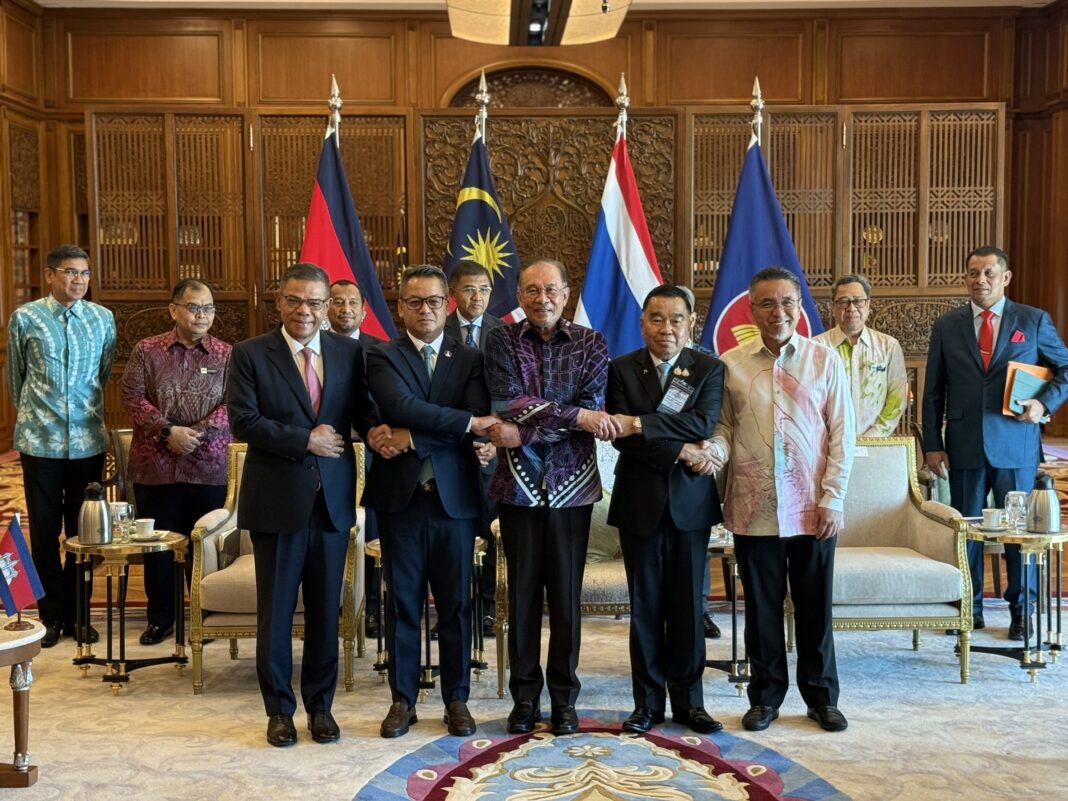- Cambodia and Thailand endorse a formal 13-point ceasefire protocol in Kuala Lumpur.
- Agreement bans provocations, troop movements, and use of force against civilians.
- ASEAN, U.S., and China participated as observers; Malaysia facilitated the talks.
What We Know
Cambodia and Thailand signed a formal ceasefire agreement Thursday in Kuala Lumpur, pledging to end hostilities and uphold peace along their disputed border. The agreement, finalized during an extraordinary General Border Committee (GBC) meeting, marks a major step in de-escalating tensions that have simmered in recent months.
The 13-point ceasefire framework was endorsed by both countries following three days of intensive negotiations. It builds upon earlier regional agreements and incorporates protective measures for civilians, a ban on troop reinforcements, and the creation of rapid-response coordination teams.
According to Bangkok Post, the meeting was attended by top military officials, including Thailand’s acting Defence Minister Gen Nattaphon Narkphanit and Cambodia’s Deputy Prime Minister and Defence Minister Gen Tea Seiha. The Malaysian Chief of Defence Forces served as facilitator, while international observers from China, the United States, and Malaysia (as ASEAN chair) were also present.
What They’re Saying
Thailand Reaffirms Peaceful Intent and Legal Commitment
According to an official statement from the Royal Thai Government, Deputy Defense Minister Gen Nattaphon Narkphanit, head of the Thai delegation, paid a courtesy visit to Malaysian Prime Minister Anwar Ibrahim at 0930 hrs (local time) upon arriving in Kuala Lumpur. He expressed gratitude to Malaysia for its role as ASEAN chair and facilitator of the GBC talks, while reiterating Thailand’s commitment to resolving the Cambodia border conflict through peaceful means and in line with international law.
Later, at 1400 hrs, Gen Nattaphon and high-ranking Thai officials — including Chief of Defense Forces Gen Songwit Noonpackdee, senior staff from the Royal Thai Army, Navy, and Air Force, as well as representatives from the Ministry of Foreign Affairs and Ministry of Interior — attended the GBC meeting alongside Cambodian counterparts. Observers from the United States and China were also present.
The Thai side emphasized four key goals: restoring mutual trust between military forces, agreeing on the ceasefire, reducing tensions in high-risk areas, and safeguarding civilian lives. The Deputy Defense Minister reaffirmed Thailand’s intention to pursue lasting peace based on dignity, fairness, and international humanitarian principles.
“We’ve reached a comprehensive understanding that ensures the safety of our people and the stability of our border,” said Gen Nattaphon, who co-chaired the meeting on behalf of Thailand.
His Cambodian counterpart, Gen Tea Seiha, added: “This agreement is not just a ceasefire; it is a commitment to future peace and cooperation between our nations.”
The Big Picture
The ceasefire protocol outlines several core commitments:
- A total and unconditional ceasefire with no attacks on civilian or military targets.
- No movement or reinforcement of troops along the Cambodia–Thailand border.
- Refraining from provocations, airspace violations, or construction of new military infrastructure.
- Respect for humanitarian law, including the treatment of captured soldiers and return of deceased individuals.
- Regular communication between regional commands and ministers to prevent escalations.
Malaysia’s role as facilitator drew praise from both delegations. Earlier in the day, Gen Nattaphon paid a courtesy visit to Prime Minister Anwar Ibrahim in Putrajaya to express gratitude for ASEAN’s continued support of peace efforts.
📄 Click here to read the full ceasefire agreement (English version)
What’s Next
Both nations agreed to schedule the next GBC meeting within one month. If not, an emergency session with the same format will be convened. ASEAN observer teams, led by Malaysia, will monitor implementation through regional border committee reports and on-the-ground inspections.
The agreement also creates a mechanism for addressing any unintentional armed conflict at the local level before it escalates — a key safeguard in preventing renewed violence.
Putin-Trump Meeting Venue Confirmed: Kremlin Says Announcement Coming Soon
United Airlines Cancels 1,000+ Flights After Major Tech Outage
Follow Virginia Times for regular news updates. Stay informed with the latest headlines, breaking stories, and in-depth reporting from around the world.
A global media for the latest news, entertainment, music fashion, and more.















